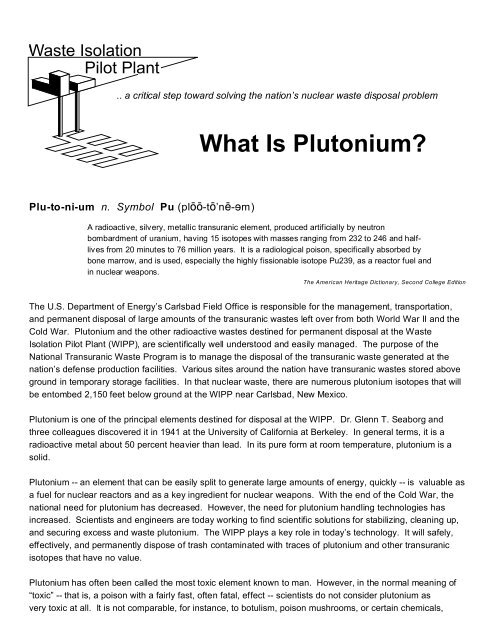What is Plutonium? - Fact Sheet - Waste Isolation Pilot Plant - U.S. ...
What is Plutonium? - Fact Sheet - Waste Isolation Pilot Plant - U.S. ...
What is Plutonium? - Fact Sheet - Waste Isolation Pilot Plant - U.S. ...
Create successful ePaper yourself
Turn your PDF publications into a flip-book with our unique Google optimized e-Paper software.
\<br />
.. a critical step toward solving the nation’s nuclear waste d<strong>is</strong>posal problem<br />
Plu-to-ni-um n. Symbol Pu (pl-t’n-m)<br />
<strong>What</strong> Is <strong>Plutonium</strong>?<br />
A radioactive, silvery, metallic transuranic element, produced artificially by neutron<br />
bombardment of uranium, having 15 <strong>is</strong>otopes with masses ranging from 232 to 246 and halflives<br />
from 20 minutes to 76 million years. It <strong>is</strong> a radiological po<strong>is</strong>on, specifically absorbed by<br />
bone marrow, and <strong>is</strong> used, especially the highly f<strong>is</strong>sionable <strong>is</strong>otope Pu239, as a reactor fuel and<br />
in nuclear weapons.<br />
The American Heritage Dictionary, Second College Edition<br />
The U.S. Department of Energy’s Carlsbad Field Office <strong>is</strong> responsible for the management, transportation,<br />
and permanent d<strong>is</strong>posal of large amounts of the transuranic wastes left over from both World War II and the<br />
Cold War. <strong>Plutonium</strong> and the other radioactive wastes destined for permanent d<strong>is</strong>posal at the <strong>Waste</strong><br />
<strong>Isolation</strong> <strong>Pilot</strong> <strong>Plant</strong> (WIPP), are scientifically well understood and easily managed. The purpose of the<br />
National Transuranic <strong>Waste</strong> Program <strong>is</strong> to manage the d<strong>is</strong>posal of the transuranic waste generated at the<br />
nation’s defense production facilities. Various sites around the nation have transuranic wastes stored above<br />
ground in temporary storage facilities. In that nuclear waste, there are numerous plutonium <strong>is</strong>otopes that will<br />
be entombed 2,150 feet below ground at the WIPP near Carlsbad, New Mexico.<br />
<strong>Plutonium</strong> <strong>is</strong> one of the principal elements destined for d<strong>is</strong>posal at the WIPP. Dr. Glenn T. Seaborg and<br />
three colleagues d<strong>is</strong>covered it in 1941 at the University of California at Berkeley. In general terms, it <strong>is</strong> a<br />
radioactive metal about 50 percent heavier than lead. In its pure form at room temperature, plutonium <strong>is</strong> a<br />
solid.<br />
<strong>Plutonium</strong> -- an element that can be easily split to generate large amounts of energy, quickly -- <strong>is</strong> valuable as<br />
a fuel for nuclear reactors and as a key ingredient for nuclear weapons. With the end of the Cold War, the<br />
national need for plutonium has decreased. However, the need for plutonium handling technologies has<br />
increased. Scient<strong>is</strong>ts and engineers are today working to find scientific solutions for stabilizing, cleaning up,<br />
and securing excess and waste plutonium. The WIPP plays a key role in today’s technology. It will safely,<br />
effectively, and permanently d<strong>is</strong>pose of trash contaminated with traces of plutonium and other transuranic<br />
<strong>is</strong>otopes that have no value.<br />
<strong>Plutonium</strong> has often been called the most toxic element known to man. However, in the normal meaning of<br />
“toxic” -- that <strong>is</strong>, a po<strong>is</strong>on with a fairly fast, often fatal, effect -- scient<strong>is</strong>ts do not consider plutonium as<br />
very toxic at all. It <strong>is</strong> not comparable, for instance, to botul<strong>is</strong>m, po<strong>is</strong>on mushrooms, or certain chemicals,
where very small amounts will cause immediate death. In referring to small amounts of radioactive materials,<br />
such as plutonium, the words “toxic” and “toxicity” are used to describe their relative abilities to damage<br />
biological material rather than to kill rapidly. The effects of low-level exposures to plutonium, as well as other<br />
radioactive material, may not be detected for many years, if at all.<br />
The principal radiation from plutonium <strong>is</strong> the alpha particle. Alpha radiation <strong>is</strong> totally stopped by a single<br />
sheet of paper or even an inch of air. These alpha particles cannot penetrate the outer layer of one’s skin.<br />
Therefore, plutonium outside the body <strong>is</strong> considered harmless. Even ingestion of these materials <strong>is</strong> of<br />
relatively low r<strong>is</strong>k to humans. The greatest r<strong>is</strong>k <strong>is</strong> in inhaling plutonium particles.<br />
The r<strong>is</strong>k of plutonium, particularly that which <strong>is</strong> maintained in temporary above ground storage facilities<br />
around the country, <strong>is</strong> that it and other transuranic <strong>is</strong>otopes have the potential to be inadvertently released to<br />
the biosphere. Without proper control and permanent d<strong>is</strong>posal, plutonium can be of great r<strong>is</strong>k if it were<br />
accidently released and d<strong>is</strong>persed with subsequent exposure to nearby populations.<br />
It <strong>is</strong> a fact that after fifty years of careful handling of plutonium by humans in the nuclear industry and the<br />
nation’s weapons programs, there have been no fatalities due to plutonium exposure. The r<strong>is</strong>ks to humans<br />
from inhalation or ingestion of plutonium are calculated from scientific study of the effects of relatively large<br />
quantities of other radioactive materials in humans. R<strong>is</strong>ks from low levels of internally deposited radioactive<br />
materials are simply not measurable but, rather are calculated using conservative assumptions.<br />
Transportation of transuranic waste to the WIPP poses a van<strong>is</strong>hingly small r<strong>is</strong>k from radiation to either<br />
employees or the public. The National Academy of Science has termed the transportation system to be used<br />
for moving these wastes to the WIPP as the “safest transportation system for hazardous materials in th<strong>is</strong><br />
country.” The benefits of transporting waste to the WIPP for permanent d<strong>is</strong>posal far outweigh any r<strong>is</strong>k. For<br />
example, the radiation exposure from the shipping container <strong>is</strong> almost impossible to detect. The amount of<br />
radiation one would receive walking within 30 feet of a TRUPACT-II container can only be mathematically<br />
calculated at .00001 millirem, which <strong>is</strong> less than ten-millionth of the yearly dose received by an average<br />
person from the natural background radiation all around us.<br />
For more information:<br />
http://www.wipp.ws or call 1-800-336-W IPP<br />
U.S. Department of Energy Contact:<br />
Carlsbad Field Office DOE/CBFO Office of Public Affairs W TS Communication Department<br />
The W aste <strong>Isolation</strong> <strong>Pilot</strong> <strong>Plant</strong> P.O. Box 3090 P.O. Box 2078<br />
Carlsbad, NM 88221 (505) 234-7352 Carlsbad, NM 88221 (505) 234-7207<br />
printed on recycled paper Rev. January 2003

















